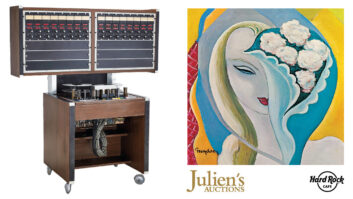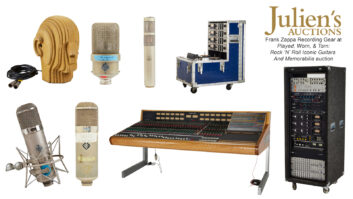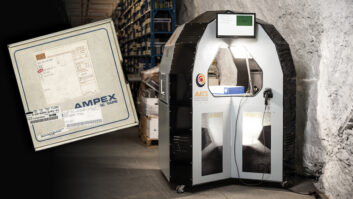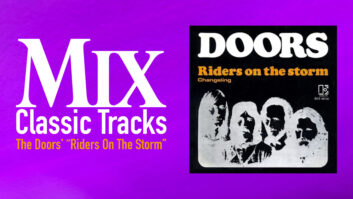While things churn in some circles, in others, it’s the tried and true that comforts us huddled masses. I recently attended a series of strategic meetings with a client in Scotland and was struck by the fact that wherever I went, I heard American music playing. Good stuff, recognized the world over.
Some performances truly are timeless, and our digital assets, once born, should be coddled. Which brings us to the topic this month: backing up. “Argh, backups,” you say, “I’ve got your backup right here!” But have you ever tried to perform a restore of your backup? Who cares if it’s backed up if you can’t restore the doggone thing?
With the slow acceptance of advanced distribution formats like DVD-A and SACD, file sizes are no longer mere 650MB trifles. An hour of 96/24 surround will consume 5.433 GB of space. A completed stereo plus surround SACD project requiring a typical amount of editing can easily weigh in at 150 GB. Now, this isn’t a scary amount of data from a management point of view, but it does require a bit of forethought, and that, now that I’ve entered humble mode, is my bread and butter.
Okay, backups. That usually means tape — data, not audio tape. You can use spare hard disk volumes, either direct or network-attached. With the cost of 30GB ATA drives down to $99, that’s an option for some. Actually, Gigabit Ethernet-attached NAS makes a great temporary storage buffer for studios needing to move files quickly off working volumes so they can be backed up later. But, for most of us, backups take the form of stationary- or rotary-head tape formats as either a stand-alone mechanism or as part of a “library,” another name for robotic autoloaders.
Libraries come in many sizes, from small, single-drive boxes holding seven cartridges to fridge-sized monsters with 20 drives and over 1 terabyte/hour sustained rates. Yup, one terabyte per hour. Granted, you may not need such powerful juju, but the ability to fill a cartridge a day for a week’s worth of unattended network backups is a real butt-saver from a disaster recovery point of view.
Let’s look at two midrange, single-source tape formats, ignoring the macho ones like LTO, DTF-2, Mammoth-2 and SDLT, which cost a premium for their superior qualifications, and the wimpy flavors, such as the original Exabyte, Travan and DDS-2 formats, which have served their purpose and should be put out to pasture. Indeed, the end of the road has come for the DDS family, with no plans to continue past the fourth generation. Looks like what the R-DAT audio format hath spawned will ride quietly into the sunset. What has trotted into town to take up residence are three budget formats whose low-end price belies their capabilities.
Billed as bigger, faster and more reliable than a DLT4000, OnStream’s ADR tape format has some interesting features at a price well within any professional’s budget. With a native capacity of 25 GB at 2 MB/second, its LVD SCSI product can be had for around $700. The drive’s several design improvements are intended to reduce tape damage and subsequent loss of data. Trouble is, they’re in trouble. OnStream’s business has been rescued by their investors, and only those on high at Philips know what the future holds for the format.
For a few hundred more, the spiffy new features (and then some) of ADR are available in my current favorite, Ecrix’s VXA format. It boasts a native capacity and transfer rate of 33 GB and 6 MB/sec, respectively. A key aspect of the format is the packetization of data written to tape, which allows for data recovery regardless of the order that the data comes in. The VXA spatially shuffles the packets to prevent tape damage or dropouts from resulting in data loss. Moreover, the heads overscan data tracks during read to reduce the need for costly precision head alignment.
Another important feature is VXA’s variable-speed transport. This lets the drive slow down when the host can’t provide sufficient data throughput to satisfy the transport, so less rewinding. Also, because this isn’t a rotary-head transport, there’s no need to wrap the tape around a drum. The tape stays in the cartridge, nice and safe.
With extremely robust storage and retrieval specs, you can get SCSI or 1394-attach stand-alone versions for under $1,000. In addition, VXA drives are being built into various vendor’s libraries for automatic backup bliss.
I mentioned three midrange formats earlier, the third being DLT1, a low-cost version of DLTtape (DLT). Space constraints prevent me from discussing it this month, but we may look at it in the future.
Given such a groovy welterweight format as VXA, you might think that would be all you’d need. Alas, for DVD-A and SACD production, a good ol’ DLT or AIT-1 drive is still needed to get the image to the replicator. But, for general network backup tasks, these affordable critters can’t be beat.
OMas, while luxuriating in the blue glow of his new DVD-A player, has been wondering what you folks want to read about in the “Bitstream” … Checkhttp://seneschal.net/for e-mail info, related links and informal test results on some ADR and VXA drives.
REMEMBER KAI WINN
If you’ve been trolling the DVD titles lately in search of vintage fun, you may remember Doug Trumbull’s 1983 sci-fi hit, Brainstorm. A vehicle for the ever gaunt Christopher Walken, Louise Fletcher, the evil Kai of Deep Space Nine fame, and the always regal Natalie Wood, the plot hinges on a VR system with direct neural interface. Anyway, the VR box used an optical tape drive to store the mental machinations of the hapless participants. What was once fiction is now reality.
MicroContinuum is the last man standing after a joint venture between Polaroid, Avid, EMC, Lucent, and LOTS Technology gave up on an optical tape-based HD DTV storage product. Polaroid and the National Institute of Standards & Technology have stuck with it, working with MicroContinuum to create a family of write-once and rewritable enabling technologies that promise ultra-capacity, long archival life and a transfer rate of 100 MB/second. That transfer rate translates into 360 TB/hour, for one transport! Just when this stuff will appear in commercial products is unknown, but the development team says a 1-terabyte-per-cartridge product is 12 to 18 months away.
By the way, they’re not the first to attempt this. Both Sony and a group effort by Creo and Euro-giant ICI worked on optical tape products in the early ’90s with not much to show for it. At the time, the huge capacity didn’t justify the cost. Nowadays, Creo makes computer-based printing equipment and Sony is probably waiting to unleash an optical tape product on the unsuspecting IT world.
PEDANT IN A BOX
TERABYTE
A terabyte (TB) is 1,000 gigabytes (GB) or 1 million megabytes (MB). In comparison, a double-sided, double-layer DVD only holds 18 GB. It’s not uncommon for many Fortune 1000 IT departments to have 50 to 500 TB of storage online. By the way, a byte is 8 bits, with bits being the smallest quanta of binary data.
DISASTER RECOVERY
This umbrella phrase covers a range of methodologies, business practices, technologies and IT strategies aimed at bringing back full functionality after a disaster. Think about where you’d be if a fire, flood or lightning strike took out your entire information infrastructure… sobering, ain’t it?
NATIVE CAPACITY
This phrase refers to the fundamental, uncompressed capacity of a device. All tape-based formats have an embedded, hardware-mediated, lossless data compression capability that provides about a 2x increase in capacity coupled with a resultant increase in throughput.







